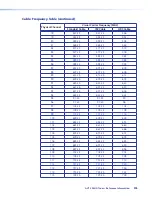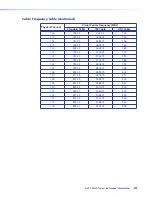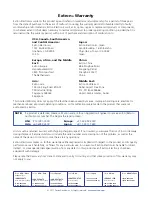
AVT 200HD Tuner • Reference Information
104
104
Setting carriage return-line feed
Unless commanded otherwise, Telnet transmits a line feed character only (no carriage return)
to the connected tuner when you press the <Enter> key. This is the correct setting for SIS
communication with the tuner. The Telnet
set
crlf
command forces Telnet to transmit
carriage return and line feed characters when <Enter> is pressed; however, if
crlf
is set, the
SIS link with the tuner does not function properly.
Closing the link to the tuner
To close the link to the tuner, access the Telnet prompt by entering the escape sequence
(<Ctrl +
]
>
). At the Telnet prompt, enter
close
.
Help
For Telnet command definitions, enter
?
at the Telnet prompt.
Exiting Telnet (Quit command)
Exit the Telnet utility by entering
quit
at the Telnet prompt. If you are connected to the AVT
200HD, access the Telnet prompt by entering the Escape sequence (<Ctrl + ]>).
Subnetting — A Primer
A subnet is a
sub
set of a
net
work — a set of IP devices that have portions of their IP
addresses in common. It is not the purpose of this manual to describe TCP/IP protocol
in detail. However, some understanding of TCP/IP subnetting is necessary in order to
understand the interaction of the AVT 200HD and the mail server gateway. To understand
subnetting at the level required to install and operate the AVT 200HD, you must understand
the concepts of a gateway, local and remote devices, IP addresses and octets, and subnet
masks and octets.
Gateways
The AVT 200HD can communicate with the e-mail server that it uses for e-mail notification
directly (if they are on the same subnet), or the communication can be routed via a gateway
(a computer that provides a link between different subnets).
Local and remote devices
The local and remote devices are defined from the point of view of the function being
described. In this guide, subnetting is an issue when you are using the controlling computer
to set TCP/IP values in the AVT 200HD (see “
Establishing an Ethernet Connection
”
in the
“Remote Configuration and Control” section).
IP addresses and octets
Valid IP addresses consist of four 1-, 2-, or 3-digit numeric sub-fields, called “octets,” which
are separated by dots (periods) (figure 65). Each octet can be numbered from 000 through
255. Leading zeros, up to three digits total per octet, are optional. Values of 256 and above
are invalid.
192.168.254.254
Typical IP Address:
Octets
Figure 65.
IP Address and Octets









































